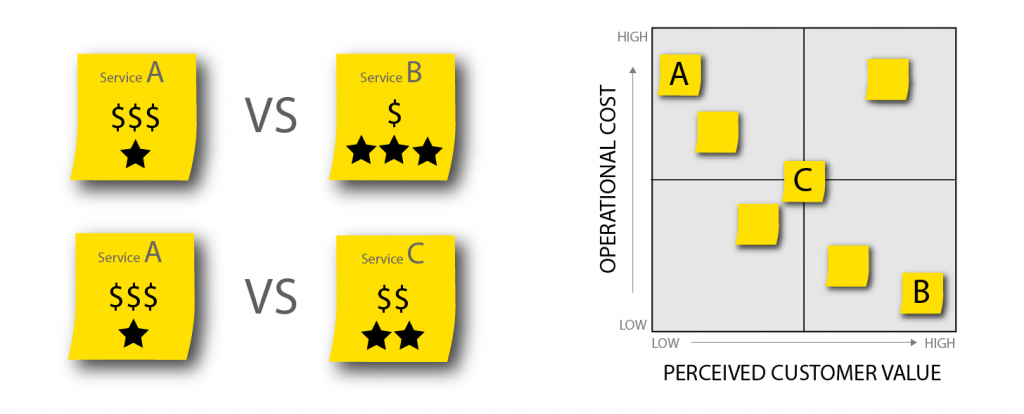How to Tidy Up Your Government Services
The Netflix show Tidying Up with Marie Kondo has taken 2019 by storm in part because it acknowledges that we all get so carried away with the things we acquire that we rarely have time to take a step back and ask why we need them. But armed with her KonMari method, Marie Kondo offers some simple tools to take back control and focus on things that are truly important.
Tidying Up got us thinking: a cluttered house and a cluttered government service portfolio have a lot of similarities. And with that in mind, how might we add a KonMari layer to our practice of service management and apply it to the work we do in government?
Consequences of a cluttered service-portfolio

Government managers are under constant pressure to improve performance and reduce the costs of the services they deliver. Under the guise of continuous improvement, agencies get caught in the allure of shiny new solutions despite the lack of new funding or resources. With all of the “buying” and none of the purging, these service portfolios start to look like the clothes closets at the beginning of a Tidying Up episode: overflowing, disorganized collections of garments complete with ugly sweaters, random brimmed hats, and a bunch of old pants that don’t fit.
In government, the immediate consequences of untidy service portfolios are angry customers and declines in service performance. Managers then rely on their help desks to detect the most emergent problem areas and triage customer issues before things spiral out of control.
There are also long-term mission impacts when a service portfolio gets cluttered. Energy and resources are constantly diverted towards competing priorities and this means customers are not being fully served somewhere else. Managers begin to lose sight of the true costs of service delivery and what it takes to deliver an exceptional customer experience. This is not the way to sustain loyal customers long-term but it is today’s reality for many government programs and services.
What “sparks joy” for government services?
When you empty that closet and begin culling through the volcano-like pile of clothes on the bed, Marie Kondo’s “spark joy” principle is straightforward. Unless you have an emotional connection to an item–a little zing of happiness when you hold it–get rid of it. Government service managers, however, have to consider factors well beyond whether a service delivers an emotional connection.
Customers use government services to achieve some kind of result or outcome. Government services “spark joy” when they meet the needs of customers and achieve the overarching policy objectives. Services have to be relevant, be usable, and deliver an exceptional experience.
How do you know if your portfolio needs tidying?
Cluttered service portfolios can sneak up on us because new requirements grow organically over time. Small, incremental additions eventually dilute the services being offered until the services cannot be sustainably managed.
Having a documented catalog of the service offerings and a governance process for adding or retiring services is one way to manage service creep. Monitoring customer behavior is another way to detect whether the service portfolio is being diluted. Low customer engagement or abandonment may indicate that the services being offered are not relevant to the problems customers are trying to solve.
Five steps to tidying your government service portfolio
Tidying up a government service portfolio simply means making decisions about which services provide the biggest value to customers in the context of the agency mission. By choosing to invest in the services that matter most to customers, we then free up resources by stopping services that are of little or no value. We have five recommended steps to tidying:
1. Define “spark joy” for your customers
Services that are designed to be easy maximize value for the customer and give the service provider the best shot of delivering the service in a cost efficient way. The specific definition of “easy” varies for each service.
Service designers immerse themselves in the customer’s world through both quantitative and qualitative analysis to define what “sparks joy” for the customer. This could be factors like speed, availability, security, or privacy. Grounded in this understanding, service designers can determine how well each unique service contributes to the things that matter most to customers.
2. Empty the closet
Service portfolios often resemble cluttered closets in that this year’s fashions bury last year’s trends. Yet, for many psychological reasons, we can’t bring ourselves to part with our now-useless purchases. Likewise, services that outlive their relevance but continue operating in the background drain limited resources. Simplifying a service portfolio to make it easy for the customer means disentangling each service and discreetly defining its value.
The way you “empty the closets” in government services is by cataloging each service in your portfolio. Pull each of these services out into the open by cataloging each one. This task can be fraught with challenges, especially among mature enterprise portfolios. Services can share the same name but behave very differently depending on the people, process, technology, content, and environment in which they operate. Each of these factors potentially impacts how easy it is for customers to use the service and how efficiently it can be delivered.
Once each service has been cataloged individually, it is now possible to document the cost to deliver each individual service and determine its perceived value to customers.
3. Decide what to keep
A service designer’s goal is to make it as easy as possible for customers to use the services. This requires eliminating unnecessary complexity from the customer journey. This is complexity that can come from redundancies, dependencies, inconsistencies, gaps, and just plain confusion of who is responsible for doing what. Before we can truly simplify each service, the initial service catalog may need to be refined and consolidated several times before it resembles the intended service model.
One successful technique is to marry the newly forming service catalog to a customer journey map which visually depicts how each individual service aligns with customer experience. This is a powerful tool for service design teams because it informs how customers perceive value at specific touchpoints. It also points to the underlying processes, technologies, and talent that are responsible for delivering the value.
Through this process, the service design team begins to zero in on the components that contribute to the overall customer experience and ultimately drive intended customer behavior.
4. Evaluate each piece
As the service catalog begins to reflect the reality of what is being delivered to customers, there is still a need to determine the marginal cost associated with delivering the customer experience. Technical Assent recommends using a pair-wise comparison that results in a ranking of each service relative to the others in the service catalog. We use two criteria–cost and perceived customer value–as shown in the diagram.
This visualization enables the service design team to understand the marginal costs and benefits of specific services in the context of their respective contributions to the customer journey.
5. Develop the service strategy
When a service portfolio is segmented this way, it sets up a productive dialogue among the service design team members and new management strategies emerge. It forces the team to consider the marginal benefit of increasing perceived customer value compared to the marginal cost. It also lends itself to relevant exploratory questions such as “what needs do our customers have that we don’t address?” The table to the right demonstrates four possible strategies that may emerge from these conversations.
Next steps

In a resource-scarce environment, it is critical that government service managers focus on achieving overarching policy objectives through a portfolio of services that delivers the biggest impact to its customers. This requires that managers, who are often policy experts, invest deeply to understand the needs and motivations of their customers.
New concepts emerge when customer preferences for relevance, usability, experience, and ease marry with a service delivery model that values efficiency, consistency, and reliability. Innovative government solutions spark joy when they address what customers care about most and meet the mission needs.
Technical Assent has consulted with numerous federal government agencies to redesign their service portfolios based on customer experience. Read more about service design in these articles.
In Government Service Design-Thinking, Thinking Like the Customer is not Enough
Avoiding the Sugar Crash of IT Modernization
This Simple Meeting Hack Helps a Problem-Solving Team Refocus on Their Customers









